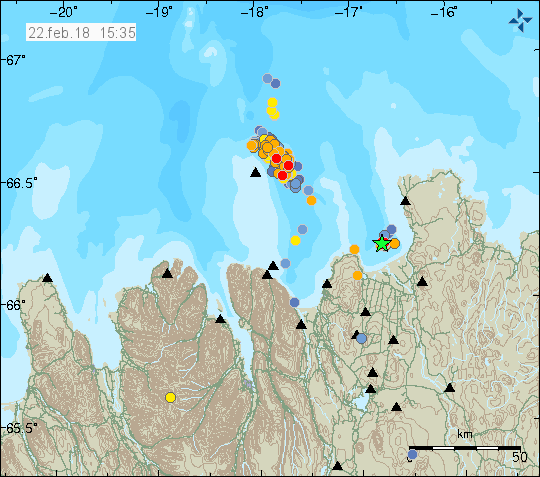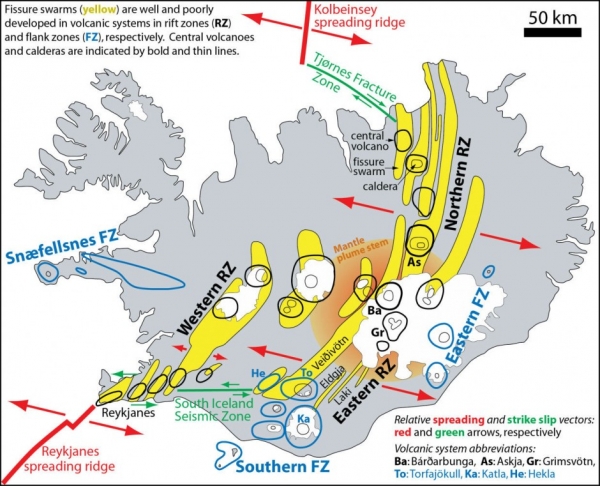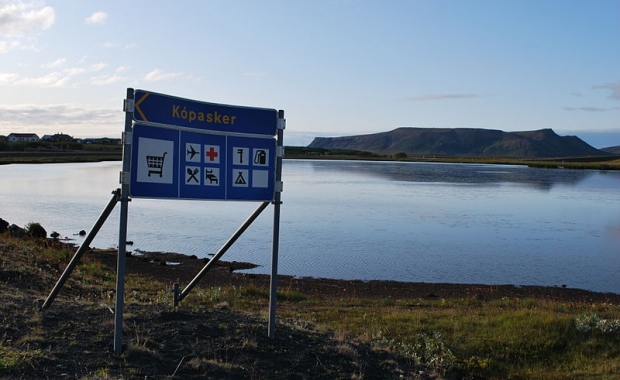The intense earthquake swarm off the north coast of Iceland appears to have changed nature and spread, a geophysicist argues The Seismic Monitoring System of the Icelandic Meteorological Office detected a sharp 3.6 magnitude quake was detected in Öxarfjörður fjord, near the village of Kópasker earlier today. Nearly two dozen smaller tremors accompanied the larger quake.
Swarm has been slowing down

The swarm, which began on Wednesday last week, continued yesterday and today, although the activity has slowed down. Only 260 quakes have been detected in the past 48 hours. When the activity peaked over the weekend more than 1,500 quakes, including dozens of powerful magnitude 3+ quakes were detected in a 48 hour period. The Icelandic Civil Protection Authority has declared an Uncertainty Phase due to the seismic activity.
Read more: Eruption cannot be ruled out: Grímsey quakes concentrated in submarine volcanic system
To date the seismic activity has been concentrated in the southern part of the submarine volcanic system of Nafir. The volcanic system is in the Tjörnes fracture zone, an area known for high levels of volcanic, geothermal and seismic activity. Several volcanic systems are located in the Tjörnes fracture zone which extends from the North East of Iceland to the north of Grímsey island, where it connects to the Kolbeinsey spreading ridge, which is part of the North Atlantic Ridge.
Today's quake points to a new pattern
The earthquake which was detected at 7:34 am suggests that the earthquake activity might be changing in nature, according to Sigurlín Hjaltadóttir, a geophysicist at the Icelandic Meteorological Office. She told the Icelandic National Broadcasting Service that a powerful 5.2 earthquake on Monday might have caused a change in the nature of the activity. Today's quake suggests the activity has spread:
The activity near Grímsey is very similar to what it has been in the past few days, it has been slowing down for the past 2-3 days. It's impossible to say what happens next. It could well be that a larger part of the system is coming alive, but we just have to wait and see.

The intense earthquake swarm off the north coast of Iceland appears to have changed nature and spread, a geophysicist argues The Seismic Monitoring System of the Icelandic Meteorological Office detected a sharp 3.6 magnitude quake was detected in Öxarfjörður fjord, near the village of Kópasker earlier today. Nearly two dozen smaller tremors accompanied the larger quake.
Swarm has been slowing down

The swarm, which began on Wednesday last week, continued yesterday and today, although the activity has slowed down. Only 260 quakes have been detected in the past 48 hours. When the activity peaked over the weekend more than 1,500 quakes, including dozens of powerful magnitude 3+ quakes were detected in a 48 hour period. The Icelandic Civil Protection Authority has declared an Uncertainty Phase due to the seismic activity.
Read more: Eruption cannot be ruled out: Grímsey quakes concentrated in submarine volcanic system
To date the seismic activity has been concentrated in the southern part of the submarine volcanic system of Nafir. The volcanic system is in the Tjörnes fracture zone, an area known for high levels of volcanic, geothermal and seismic activity. Several volcanic systems are located in the Tjörnes fracture zone which extends from the North East of Iceland to the north of Grímsey island, where it connects to the Kolbeinsey spreading ridge, which is part of the North Atlantic Ridge.
Today's quake points to a new pattern
The earthquake which was detected at 7:34 am suggests that the earthquake activity might be changing in nature, according to Sigurlín Hjaltadóttir, a geophysicist at the Icelandic Meteorological Office. She told the Icelandic National Broadcasting Service that a powerful 5.2 earthquake on Monday might have caused a change in the nature of the activity. Today's quake suggests the activity has spread:
The activity near Grímsey is very similar to what it has been in the past few days, it has been slowing down for the past 2-3 days. It's impossible to say what happens next. It could well be that a larger part of the system is coming alive, but we just have to wait and see.








